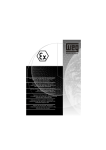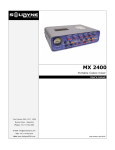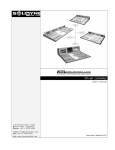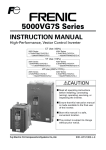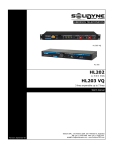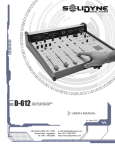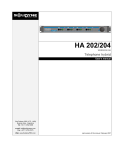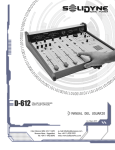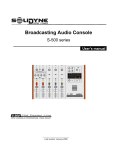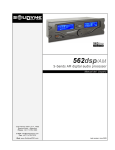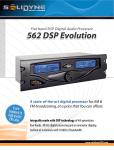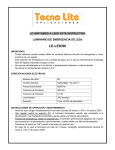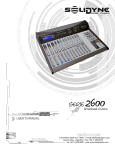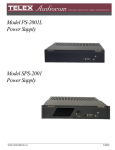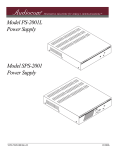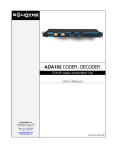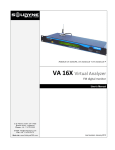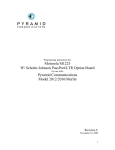Download MX2100 USB Mini-Console Brochure
Transcript
portable consoles MX 2100 Portable mini console User's manual Solidyne SRL 3 de Febrero 3254 (CP 1429) Bs As, Argentina Revision April 2015 Tel: +54 11 4702 0090 Fax: +54 11 4702-2375 e-mail: [email protected] www.SolidynePRO.com Page 2 www.SolidynePro.com Table of contents 1. Overview.....................................................................5 1.1 Features.................................................................................5 Maximize the cell phone transmission...........................................................................5 Designed for Internet......................................................................................................5 High performance...........................................................................................................6 1.1.1 Inputs.............................................................................................................6 1.1.2 Outputs...........................................................................................................6 1.1.3 Power supply..................................................................................................7 1.1.4 Portability.......................................................................................................7 1.1.5 Connectivity....................................................................................................7 2. INPUTS, OUTPUTS AND CONNECTIONS...............9 2.1 REAR PANEL.........................................................................9 2.1.1 Inputs.............................................................................................................9 2.1.1.1 Microphone inputs...............................................................................................9 2.1.1.2 Line input.............................................................................................................9 2.1.2 Input connections.........................................................................................10 2.1.3 USB power supply.......................................................................................10 2.1.4 Program output (Bal Out)............................................................................10 2.1.5 Headphones outputs....................................................................................11 2.2 LINK WITH STUDIO.............................................................11 2.2.1 Cell phone via Bluetooth..............................................................................11 2.2.1.1 Link the cell phone to the console....................................................................12 2.2.1.2 Re-connections.................................................................................................13 2.2.1.3 Adjusting the volume.........................................................................................13 2.2.2 Wired cell phone: hands free adapter.........................................................13 2.2.3 Connecting to a land-line.............................................................................14 2.2.4 Connecting to a computer...........................................................................15 2.2.5 Receiving at the studios...............................................................................16 3. USING THE CONSOLE............................................17 3.1 Front panel...........................................................................17 3.1.1 Power on......................................................................................................17 3.1.2 Program and headphones controls.............................................................17 3.1.2.1 Program mix......................................................................................................17 3.1.2.2 Headphones......................................................................................................18 3.1.3 Signal level indicator....................................................................................19 .......................................................................................................................................19 Dynamic range compression........................................................................................19 www.SolidynePro.com Page 3 3.2 Telephonic link....................................................................20 3.2.1 Cell phone....................................................................................................20 3.2.2 Land lines.....................................................................................................20 3.2.3 End the call..................................................................................................20 3.2.4 If the communication is interrupted.............................................................21 3.2.5 Connections diagram for telephonic link.....................................................21 3.3 Internet link..........................................................................21 3.3.1 Reporter or real time “mobile unit”...............................................................22 3.3.1.1 About transmission............................................................................................22 3.3.1.2 About the return from the studio.......................................................................22 3.3.1.3 Mobile unit in real time transmission.................................................................23 3.3.2 Remote studio using streaming...................................................................24 3.3.2.1 About the transmission.....................................................................................25 3.3.2.2 About the return from Studio.............................................................................25 3.3.2.3 About signals that can be managed.................................................................25 4. TECHNICAL SPECIFICATIONS..............................26 Whats in the box Inside the box you will find: 1 Solidyne MX2100 console 1 USB multivoltaje charger 1 cable mini-USB to USB-A male 1 RJ-11 to cable 1 warranty certificate. Page 4 www.SolidynePro.com 1. Overview 1.1 Features Solidyne MX2100 portable mini-console is designed to provide a low-cost professional solution for broadcasting from outside locations, using mobile telephones and the Internet. Maximize the cell phone transmission With the MX2100 you don't need to manipulate the cell phone. You can use dynamic microphones of good quality, using the cell phone only as transmitter to link with the radio station. The console can also be used with a land line or connected to a laptop. With Solidyne VQR technology into the studios, you can achieve a substantial renovation in the audio quality of telephone communication, rebuilding part of the bass and treble lost in transmission and eliminating the background noise that characterizes the conventional telephone transmissions. For hear real examples of this technology visit www.SolidynePro.com The cell phone is connected to the console via a Bluetooth wireless link, or using a cable adapter connected to handsfree connector. Bluetooth wireless technology allows to connect compatible devices without cables. A Bluetooth connection does not require that the devices be in line of sight, but the devices should be within 10 meters from each other (3 meters maximum recommended for safe operation). Connection can be subject to interference from obstructions such as walls or other electronic devices. Designed for Internet With the MX2100 eliminates the analogical connection between conventional audio consoles and the audio inputs on the laptops, which are not designed for professional use. The Solidyne MX2100 connects to the computer with a standard USB cable, which resolves the sends and returns via Internet to link with the radio. www.SolidynePro.com Page 5 The controls are designed to solve both half-duplex transmission from remote studio (streaming), as a full-duplex real time link (VoIP) with the console working as “mobile unit” which dialogue with studies. High performance All amplifiers used in MX2100 are CMOS technology, ultra-low power consumption. This design decision makes the console consumes less than 0.1 watt, ensuring a longer duration to 16 hours continuous operation. With non continuous work is normal that the battery lasts 20 to 25 hours. 1.1.1 Inputs The MX2100 has the following inputs: 3 inputs for dynamic microphones, 1/4” TRS female jack. Non-saturation pre-amplifiers with “localfeedback” technology by Solidyne. 1 built-in condenser microphone (shares the knob with the line input). 1 line input (mono), compatible with headphone output of portable players and digital recorders. USB port for Internet streaming (using a laptop). Bluetooth communication can be on-air (to link with a second MX2100). 1.1.2 Outputs The program signal is compressed by an automatic dynamic range compressor, which maintain constant the output level. This prevents the operator has to be constantly manipulating the knobs (enables the journalist to operate the console). MX2100 outputs are: Page 6 Program output (PGM): Gives the mix that is send to the Studios. Balanced with TRS connector. Impedance 10 KOhms. www.SolidynePro.com Headphones outputs (cue): 3 outputs for headphones. Headphone mix combines sources and return signals according to the connections diagrams. RJ11 to land-line or wired cell phone. Bluetooth to link to studios or remote journalist. USB port for streaming via Internet (using a laptop). 1.1.3 Power supply Internal Battery Ni-Cd batteries allowing 16 hours of continuous operation. They are typically 20 to 25 hours of non continuous operation. The internal battery charges through the USB connector that can connects to the external USB charger, provided with the console, or directly to a computer. 1.1.4 Portability The unit has a hook "U" that allows to use the console belt hanging near the phone. MX2100 has extensive protection against RF interference. With GSM digital phones are advised, however, a minimum distance of 20cm. Its small size and low weight (only 600 gr) make it very comfortable to operate. 1.1.5 Connectivity • USB port for Internet link (requires a laptop). • Bluetooth for cell phone link with studios, or for calling a remote journalist when the consoles works as remote studio. • Wired link to cell phone via hands free connector. • DTMF keypad to dial with land lines. www.SolidynePro.com Page 7 Page 8 www.SolidynePro.com 2. 2.1 INPUTS, OUTPUTS AND CONNECTIONS REAR PANEL REAR PANEL 2.1.1 Inputs 2.1.1.1 Microphone inputs The console Solidyne MX2100 has 3 microphone inputs (MIC-1, MIC-2, MIC-3) using ¼” TRS connectors. Pre-amps use a technique called "local feedback" that avoids saturation when the sound pressure level over the microphone capsule is high (e.g. a sports relater who cries a goal). Built-in microphone: The built-in microphone (MIC-4) are located at the frontal panel. This microphone shares the volume knob with the line input and the Blutooth. WARNING: MIC-4 is disabled when USB (either connected to a computer or to the charger) or the LINE input is plugged. According to the work mode, different signals are switched to the knob 'MIC-4/LIN/Bluetooth' (see “3 – Using the console”). 2.1.1.2 Line input LIN-4 is a line input (mono). Supports direct connection to the headphones output of analog and digital portable players, MP3 recorders, IPods, etc. Use a standard stereo miniplug cable to connect it (at the console the ring leaves unconnected). www.SolidynePro.com Page 9 2.1.2 Input connections LIN-4 Microphones GND Sleeve Ring Balanced (+) Tip Balanced (-) Sleeve Tip GND Signal If connects a stereo signal to line input, take in mind that this input is monoaural, so only the left channel will be used. A plug-plug stereo TRS cable can be used without risk, since at the console the ring (right channel) leaves unconnected. 2.1.3 USB power supply The console can be operated without external power for 16 hours in continuous use due to its CMOS chipset technology. It has a rechargeable Ni-Cd battery. After a full discharge, the battery requires about 12 hours of connection to reach its full charge. Above this value reduces the load current, and can stay connected without risk. The console is provided with an external USB charger. The switching charger is multivoltage and can connects to any outlet of 100/240 VAC. The charger connects to the console using an USB to mini-USB cable. When you connect the charger to the console, a red LED (CHG) lights indicating the unit is recharging. THIS LED WILL BE LIT WHILE THE UNIT IS CONNECTED TO THE CHARGER. The console also recharges when is connected via USB to a computer. 2.1.4 Program output (Bal Out) The program output is balanced, monoaural, using a TRS connector (Sleeve = GND, Ring = signal [-] Tip = signal [+]). This output sends the signal from the program mix, that is, the sum of the signals MIC-1, MIC-2, MIC-3/USB and MIC4/LINE/Bluetooth. Page 10 www.SolidynePro.com Balanced output TRS (Plug) to balanced input XLR Balanced output TRS (Plug) to unbalanced input (stereo TRS o RCA mono) The program signal is processed by a compressor to reduce the dynamic range, avoiding differences of levels on the air or distortion on the telephone line due to signal peaks. This output can connect to a portable digital recorder to obtain high quality recordings. The 'Bal Out' signal can be sent to Studios using a VHF/UHF radio link to transmit with studio quality (30-15.000 Hz) 2.1.5 Headphones outputs There are three outputs for headphones with 1/8” minijack connectors. The mix sent to the headphones is generated internally, and depends on how is connected the console, that is to say, the working setting. See “3 - Using the console” 2.2 LINK WITH STUDIO 2.2.1 Cell phone via Bluetooth MX2100 can be used with a Bluetooth mobile phone to transmit to studios; or to add the cell phone calling to the transmission when the link to studios is doing via Internet. Any cell phone with Bluetooth interface can be paired to the MX2100, avoiding the use of adapters cable, which differs with each cell phone. The cell phone may be up to 5 meters away from the console. We recommend wearing, but not beside to the console. The shirt pocket, or hang on the waist www.SolidynePro.com Page 11 opposite side of the console, are good places. The Bluetooth wireless connection has better audio quality since the signal remains in the digital domain from the cell phone to the MX2100. 2.2.1.1 Link the cell phone to the console By linking cell phones to the console creates a link between two devices, and allows the phone to remember the unique ID of the console (ID). Do you need to make this only the first time that use the phone. Once the console and the phone are linked, the console automatically connects to these phone when you enables Bluetooth on both devices. Procedure: 1. At the console: Enables the discovery mode. With Bluetooth switched off (LED located at dial numpad is off) press and hold # and 9 on DTMF keypad (5 seconds approx) until the LED flashes alternating green and red. This flashing indicates the “discovery mode”, and the MX2100 can be found by the cell phone. To enable Bluetooth, press and hold the numbers # and 9 on the DTMF keypad by 2 seconds. Release the buttons just when LED lights. Led will flash in green slowly, indicating Bluetooth enabled. If you hold BLUET button more that 2 seconds (5 sec approx) Bluetooth changes to “discovery” mode (toggling green and red). If you stay holding longer time will power off the Bluetooth. 2. At the cell phone: search for Bluetooth devices. This procedure varies by brand and model cell, see the instruction manual of the phone. 3. When the cell phone finds the MX2100's Bluetooth device, shows the code “BTH-008” or “BTM751” on screen. When the phone asks for the password, enter 0000 (default). See your phone's manual for details. 4. Page 12 In the front panel of the console, the light will change to green flashing slow, indicating that Bluetooth is active. MX2100's ID is now stored at the cell phone's memory. Is not necessary to repeat this procedure for this cell phone. www.SolidynePro.com In some cell phones, it is necessary to "connect" the new device found to active it. In others, the new device is activated after being detected. If there are other Bluetooth devices near to the MX2100, turn off Bluetooth on the MX2100, repeat the search in the cell phone and write-down the existing devices. Then turn on Bluetooth in the MX2100 and search again. The new displayed (BTM-751) is the MX2100. 2.2.1.2 Re-connections To reconnect the cell phone before linked, turn on the MX2100's Bluetooth pressing 2 seconds # and 9; and enables Bluetooth at the cell phone (if necessary, some cell phones disables Bluetooth device when turn it off). To make or receive a call, the audio is sent to the console. 2.2.1.3 Adjusting the volume VERY IMPORTANT: At the cell phone, Bluetooth volume must be settled at maximum level in order to obtain a good reception and to sure the best signal to noise ratio. This adjusting must be done with a real calling using Bluetooth Usually, the volume of the phone's speaker is independent of the volume of Bluetooth device. If the user change the phone's level without make a Bluetooth calling, only the volume for the phone's speaker is changed, not the Bluetooth level. To change the Bluetooth level, make a call using the console (or a hands free headset) and set the Bluetooth level to the maximum. This setting is stored at the cell phone's memory. To turn off MX2100's Bluetooth, press and hold “#” y “9” until the LED turn off. 2.2.2 Wired cell phone: hands free adapter “Cellular & Phone” supports direct connection of a cell phone using the "hands free" connector. This cell phone is used to link to the Studios. This connection is rarely used, reserved as backup of the Internet link in situations where Bluetooth is used to send the air to another phone. This connection differs by brand and model of phone. You must purchase the hands free headset for your cell phone and consult your phone's documentation to make the connection as the diagram below. www.SolidynePro.com Page 13 The cell phone manages through this connector the audio signals. The console sends PGM signal to the cell, which transmits to the radio. The radio sends back to the telephone, which enters through the cell phone to the console and sent to the headphone mix (Studio). Usually, the microphone and speaker phone are disconnected while using the audio connector for hands-free. 2.2.3 Connecting to a land-line The console connects to the telephone line through connector “Cellular & Phone”, RJ-11 type. Through the phone line the console sent the program mix to the studios and receive return from the studios, adding to headphone mix. MX2100 has a DTMF keypad to dial with land lines. To dial up: • Take the line pressing the button “On air”. • Listen the dial tone in headphones. Page 14 www.SolidynePro.com • Dial the phone number. • To talk, you can use the built-in microphone (Line-1 / MIC), or a microphone connected to the console (recommended). Both signals are sent to studios via land line. The RJ-11 connections are: 1 No connected 2 LINE 3 LINE 4 No connected RJ11 connections to land line. This is the a standard cable for land lines. 2.2.4 Connecting to a computer MX2100 console has been designed to simplify the connection to laptops for transmission via Internet streaming. The USB connection solves sends and returns of the signal with Studio. To connect it you needs a standard cable mini-USB to USB-A male. By connecting the MX2100 to a computer running Windows© XP/Vista/7, Linux or OS-X operating system recognizes the console and install the necessary drivers. No additional drivers are needed. Windows© will use the USB device as default device. The console is detected as a stereo playback channel, where the computer sends audio to the MX2100 (USB playback device) and a recording device, where the computer receives audio from the MX2100 (USB recording device). USB DETECTION Windows 7: Verify that the OS has correctly recognized the audio recording device. If Windows 7 was recognized erroneously as a "microphone device" transmissions will be mono (same signal in both channels). To correct this go to Control Panel → Sound → Record → choose the USB device (shown as a USB microphone) and click [Properties]. Then select the tab "Advanced" and display the recording formatting options and select "2 channels, 16 bits, 44.1 KHz". Windows XP: Check the output level at the Windows mixer (“Programs → Accessories → Entertainment → Mixer”). www.SolidynePro.com Page 15 2.2.5 Receiving at the studios For telephonic links (Bluetooth, wired cell phone or land line), at the Studios the signal of MX2100 is received using a standard telephone hybrid. To achieve good results it is recommended to use professional quality equipment. Solidyne provides high quality telephone hybrid, both rackmount units (Series HL-202 and Bluetooth HL-203VQ) and built-in systems into the on-air consoles. In addition, hybrids may include Voice Quality Restoration (VQR®), a technology developed by Solidyne which allows the reconstruction of the low and high frequency components losses in the telephone communication; and eliminate background noise. The operator adjusts the degree of restoration. This technology expands the performance of MX2100, allowing high quality transmission on location using conventional phone lines (land or cellular). We recommend listening to the VQR® demos spots at www.solidyne.com.ar When transmission is made via Internet using a laptop, at the studios the signal is received with a computer that downloads the audio streaming, manually with a standard audio player, or automated by an assistant software (i.e.: Solidyne Audicom). Page 16 www.SolidynePro.com 3. USING THE CONSOLE 3.1 Front panel 3.1.1 Power on Pressing “ON” the console starts up, either the console is connected to a charger or operating with internal battery. When the unit is connected to USB, to the charger or computer, charging indicator LED ("CHG") is on, while the console is off. The battery has autonomy of 16 hours in continuous use. The total charge time is 12 hours, there being no damage if stays connected indefinitely, as the charging system MX2100 automatically reduces the load current to get it to 100%. ALWAYS REMEMBER TO TURN OFF THE CONSOLE AFTER USE IT. 3.1.2 Program and headphones controls 3.1.2.1 Program mix The program signal (PGM) is generated from the mix of signal sources: MIC-1, MIC-2, MIC-3, MIC-4 (internal), LINE, Bluetooth and USB. The simultaneous availability of different inputs depends on how you connect the console. PGM is sent to Studios via telephone or using a computer with Internet access. PGM is also present in the connector 'BAL OUT' at rear panel. The knob MIC-3/USB sends the microphone connected to input MIC-3 or the computer connected to USB. www.SolidynePro.com Page 17 WHEN THE CONSOLE IS USED FOR FULL-DUPLEX REAL-TIME LINK, ALWAYS CONNECT THE MICROPHONE TO THE INPUT MIC-3, since it switches the USB return for direct monitoring in headphones. In this condition USB is not available for PGM ("3.3.1 Remote Studio"). The knob 'MIC-4/LIN/Bluetooth' manages the signal from the built-in microphone; the LINE input or the Bluetooth device, depending on the connections of the console: • The signal from the internal microphone (MIC-4) is available when no USB connection (either a computer or charger) or line input are being used. • The signal line is available when the "LIN-4" input on the rear panel is plugged (MIC-4 is canceled). • The return Bluetooth is available for PGM mix only when the console is used connected by USB (assuming that transmission is via streaming, being Bluetooth enabled put a cell phone on-air from the MX2100). 3.1.2.2 Headphones The signal present on the headphone mix change depending on how the console is connected in the different work scenarios: (a) If the communication with the studio is made using the land line or the cell phone, in headphones the available signal are: • PGM mix conformed by the inputs MIC-1, MIC-2, MIC-3 and Line/MIC-4. • The return signal from studios; that incomes from the hybrid or Bluetooth. (b) If the communication is unidirectional using Internet (the console connected via USB to a laptop) the return from studios is not used due to delays that generates the streaming; so the signals available at the headphones are: • The PGM mix conformed by the inputs MIC-1, MIC-2; USB and Bluetooth (used to put on-air a cell phone). Page 18 www.SolidynePro.com • Hybrid's return. (c) If the communication is full duplex via Internet (using a VoIP software with the laptop, see “3.3.1 – Reporter or real time mobile unit”) there is no delays. The signals available at the headphones are: • The PGM mix conformed by MIC-1; MIC-2; MIC-3 and LINE. • The return from USB (return from studios). • The return from Bluetooth and return from hybrid. The operator does not need to send the signal received from the MX2100. The reporter will hear yourself in the mix of program. The headphones noise floor increases when the Hybrid is enabled (ONAIR button pressed). Verify that this button is not pressed when not using the hybrid. 3.1.3 Signal level indicator The console features a two-level LED's indicator that shows the action of the internal compressor. The green LED illuminates when the signal level is below the action of the compressor. When the signal begins to compress, red LED lights. The higher compression will produce more brightness red LED. The appropriate level of work achieves when peaks lights the red LED occasionally. Dynamic range compression The MX2100 incorporates an audio compressor + limiter of automatic action, which take effect on all outputs of the console to maintain peak output signal at a constant level. This improves the signal to noise ratio on all transmission channels. www.SolidynePro.com Page 19 3.2 Telephonic link The communication is done from the phone connected to the console, either land-line or cell phone (See “2.2 link with the radio station”). The following describes the procedure for both cases: 3.2.1 Cell phone If the cell phone is linked via Bluetooth, call to the radio station from cell phone. Once established the call, use the microphone and headphones connected to the MX2100 to talks with Studios. The radio also can call to you. In this case you will hear the ring tones at the headphones, You can answer from the cell phone or by pressing '#9' on the console's keypad. If the cell phone is connected using a cable adapter to the handsfree connector, first make the call, once established the communication, press the PHONE button on the console and plug the cable to the "hands free” on cell phone (the cable must be connected to the RJ-11 of MX2100). From this moment you must use the microphone and headphones connected to the console to talk with studios. 3.2.2 Land lines Take the line by pressing the PHONE button and dial the destination number using the console's DTMF keypad. Once in communication, you can talk with studies using the microphone and headphones connected to the console. The program signal (console output) is sent to the radio through the telephone. The return from the studios comes to the MX2100 and sent to headphones. 3.2.3 End the call To end a land line communication, release the PHONE button. This action will hang up the line. In the case of a cell phone, simply end the calling using the cell phone (see the phone manual, “hands free" operation). Page 20 www.SolidynePro.com 3.2.4 If the communication is interrupted... As the cell phone ends the call when the connection is broken, you can wait for the radio to call and respond by pressing YES/SND on the cell phone, or '#9' on console's keypad. When answer, the radio link is restored. If you are using a land-line and communication lost, release the ON-AIR to make or receive a new call. If you receive a call from studios, answer directly from the console by pressing ON-AIR. 3.2.5 Connections diagram for telephonic link 3.3 • The console links to studios using a Bluetooth cell phone. As backup of the transmission can be connected a land line. • The return from studios comes, via Bluetooth, directly to the headphones mix. • Sent to air mixture up to three microphones, and a line input for connecting, for example, a portable recorder (the connection of LINE input disables the built-in microphone). Internet link According to the characteristics of the different sets for transmission over the Internet, each with specific use and connection, the MX2100 is used in different ways. Below are described typical cases. www.SolidynePro.com Page 21 3.3.1 Reporter or real time “mobile unit” 3.3.1.1 About transmission This case refers to full duplex transmission to Studios. The console connects via USB to a laptop with Internet access. The link with the studio is done with the laptop using a VoIP software (like Skype(c)) which provides great audio quality with minimal delay even with low bandwidth. ATENTION: THE OPERATOR AT THE STUDIOS DON'T MUST SEND THE BACKGROUND MUSIC TO THE MX2100. FROM STUDIO, ONLY THE SPEAKERS VOICES MUST BE SENT TO REMOTE CONSOLE. The Skype(c) is half-duplex. The background music can cause interruptions on-air. Connections to Bluetooth cellular and landline can be used as a backup of Internet link. If under this conditions, Bluetooth is used to link with the radio in case of emergency, the knob 'MIC-4/LIN/Bluetooth' MUST STAY CLOSED to avoid a loop. The Bluetooth return signal is directly sent to the headphones mix. 3.3.1.2 About the return from the studio The mix generated in the MX2100 is sent via USB to the laptop, which transmits it to the studio. From the laptop, the return from the studio comes to the console via USB, adding directly to the headphone mix. The operator of the MX2100 hears at headphones the return from studio and the program mix (MIC1, MIC2, MIC3). The USB input is present in the knob 'MIC-3/USB'. The connection of a microphone into the MIC-3 produces the switching of the USB signal to the headphone mix. In a full-duplex link with Internet Studies, you must ALWAYS connect the microphone to the input MIC-3, to produce the switching of USB to headphones. If you do not connect MIC-3, the return from Studio will not hear. The USB signal present for PGM on the knob 'MIC-3/USB' can not be used because you'd be sending on-air the return from studio. Page 22 www.SolidynePro.com 3.3.1.3 Mobile unit in real time transmission www.SolidynePro.com Page 23 3.3.2 Remote studio using streaming Page 24 www.SolidynePro.com In the previous case, the MX2100 is a remote studio, which transmits to the radio station. The link is half-duplex, using a high quality audio streaming. 3.3.2.1 About the transmission The console connects via USB to a laptop with Internet access. The link with the radio is done from the laptop, using an software to generate the streaming to the Studio. Skype does not apply in this case since it's only usefull for voice, and in this scenario the console sends high-quality stereo audio. As backup link you can use a wired cell phone or landline, connected to the RJ-11. 3.3.2.2 About the return from Studio A unidirectional streaming has the advantage that allows sending high quality audio, but you can not talk to with studio by the delays introduced in the transmission. Therefore in this condition the entire aired signal is generated from the MX2100. Return from studio is not used. 3.3.2.3 About signals that can be managed Mics & lines: 2 mic's are availables, connected to inputs MIC-1 and MIC-2. The input MIC-3 remains NOT CONNECTED to enable the USB signal for the PGM mix, that is to say, to send audio from laptop. Remember that when you plug MIC-3 the USB signal switches to the headphone mix, for the case of a full-duplex link with studio. Cell phone: The phone connected via Bluetooth allows sending on-air a calling (MIC-4/LIN/Bluetooth). Also you can link to a second MX2100 via cell phone. When the console is connected via USB, either a computer or the charger, the internal mic is disconnected (MIC-4) and appears instead the Bluetooth return. This allows send to air a calling when Bluetooth is used to link with the MX2100 studies (assuming that the link does the computer). The Bluetooth signal is always present in the headphone mix, with fixed level. When you send Bluetooth on air from 'MIC-4/LIN/Bluetooth'; check the level by watching the level meter on the console. www.SolidynePro.com Page 25 4. TECHNICAL SPECIFICATIONS 4 Microphone inputs; 3 external dynamic MIC and one internal condenser MIC. Audio inputs 1 line (mono) to connect portable recorders. USB to connect a laptop MIC Input levels Audio outputs Hybrid outputs From -20 dBu to -75 dBu. Non clipping MIC amplifier at any level. Balanced audio output 0 dBu / 10 Kohms. USB to connect a laptop 2 outputs with internal Hybrid. One for phone line (POT) and one for cellular phone. Bluetooth. Headphones 3 headphones output. Z= 8 to 600 Ohms. outputs Frequency Flat 20-15.000 Hz plus an anti-pop filter with -6 dB @ 30 Hz response and Low pass filter -3 dB @ 12 KHz. Noise 0 dBA Signal/Noise ratio with -40 dBu MIC level THD Less than 0,4 % @ 1 Khz. Audio 16 dB action with 2 LED indication. compressor 10 ms attack time and 200 ms recovery. Fast limiter Peak limiter after compressor stage to avoid digital saturation of cellular phones. Electronic ull use of advanced CMOS amplifiers with very low power technology consumption , for long battery duration. Cellular Bluetooth. Support cable adapter to hands-free connector. connectio Battery charger Multivoltage USB adapter. 90 V to 240 V battery charger, with automatic voltage selection Battery duration MX2100 works continuously during 16 hours. Can be charged in one night Dimensions & Dimensions: 121 mm x 129mm x 37 mm Weight Weight: 600 gr (0,6 Kg) Page 26 www.SolidynePro.com www.SolidynePro.com Page 27




























